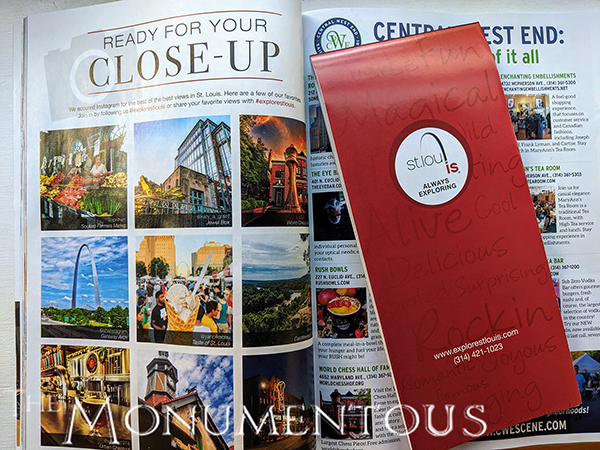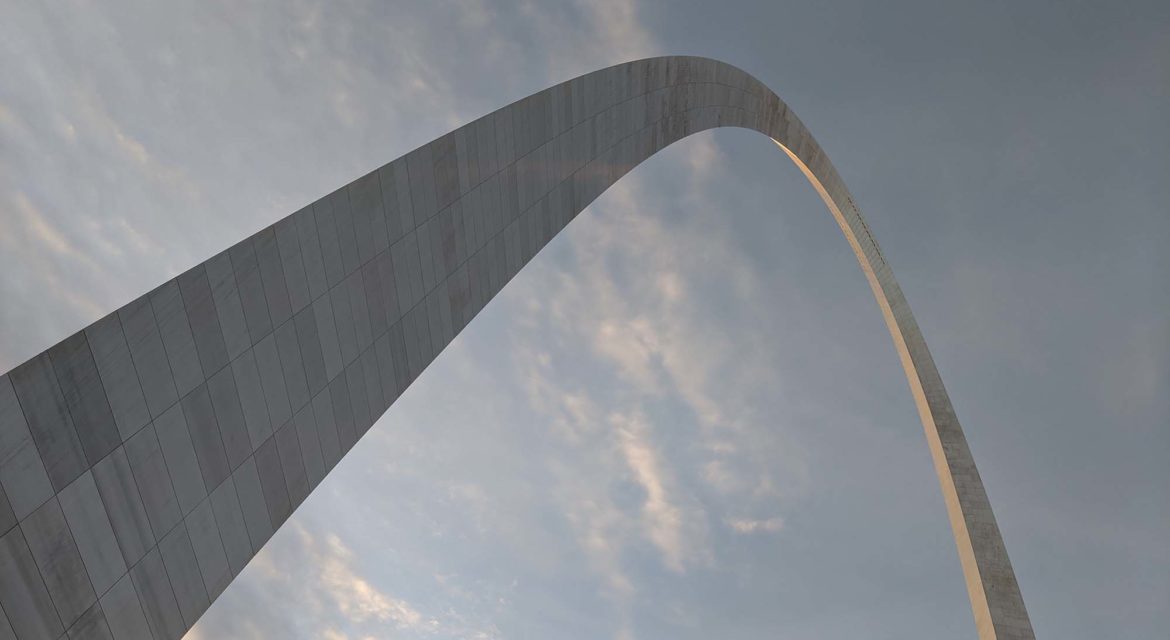 Sitting along the west bank of the Mississippi River in St. Louis, Missouri, the Gateway Arch dominates the space in multiple ways. Taking its name from the role that St. Louis played as a “Gateway to the West” in the 1800s, the Arch has enabled incredible experiences for visitors and completely transformed the city.
Sitting along the west bank of the Mississippi River in St. Louis, Missouri, the Gateway Arch dominates the space in multiple ways. Taking its name from the role that St. Louis played as a “Gateway to the West” in the 1800s, the Arch has enabled incredible experiences for visitors and completely transformed the city.
Completed in 1965, the Gateway Arch stands as a symbol of national identity and an iconic example of mid-century modern design. The world’s tallest arch has become an icon of St. Louis that has created an incredible cultural impact on the entire area while also serving as an important popular tourist destination that drives direct and indirect revenue for the city and many other businesses.

From Jefferson Memorial to Gateway to the West
 In the early 1930’s an effort to create a permanent public memorial that would commemorate the Louisiana Purchase and the subsequent westward movement of American leaders like Thomas Jefferson and pioneers like Lewis & Clark was begun. After many deliberations, the approval of a memorial came from the federal government, allocating an 82-acre area on the St. Louis riverfront as the first National Historic Site.
In the early 1930’s an effort to create a permanent public memorial that would commemorate the Louisiana Purchase and the subsequent westward movement of American leaders like Thomas Jefferson and pioneers like Lewis & Clark was begun. After many deliberations, the approval of a memorial came from the federal government, allocating an 82-acre area on the St. Louis riverfront as the first National Historic Site.
In 1947 a national architectural competition was launched to determine the design of the memorial that would evoke the grand scale and drama of the nation’s westward expansion. The arch designed by Eero Saarinen was unanimously chosen as the winner. The Arch was Saarinen’s first great triumph, but there would be many more in his career.
Forty blocks of St. Louis were demolished to enable the eventual construction of the Arch that took place between 1963 and 1965. Numerous delays and lawsuits kept the Arch from being completed in an especially timely manner, but Vice President Hubert Humphrey dedicated it in 1968. The final width and height of the arch are 630 feet, making it the tallest memorial in the United States and the tallest stainless steel monument in the world.
Known as the Jefferson National Expansion Memorial until 2018 when it became Gateway Arch National Park, all of this history is directly referenced in the museum beneath the Arch that also houses several hundred exhibits about the United States’ westward expansion in the 19th century. This history is just one of the many experiences at Gateway Arch though.
Experiences at the Top, Underneath and Around the Arch
The entire Jefferson National Expansion Memorial consists of the Gateway Arch and grounds (about 62 acres), plus another 30 acres encompassing the Old Courthouse, Luther Ely Smith Square, and many of the surrounding streets.
The 70,000-square-foot Visitor’s Center is located directly below the Arch. It traces the story of the Native Americans, explorers, pioneers, and rebels who made America possible. Featuring 201 years of history within six themed exhibit areas, this innovative and interactive museum celebrates America’s pioneering spirit and explains the westward expansion of the United States with an emphasis on St. Louis’ role in that era. The galleries span from 1764 to 1965 with topics covering Colonial St. Louis, Jefferson’s Vision, Manifest Destiny, The Riverfront Era, New Frontiers, and Building the Gateway Arch.
 A four-minute tram ride up to the viewing platform at the top of the arch provides visitors with an incredible look at St. Louis and onto Illinois. Sixteen windows face east toward Illinois and the same number face west for views of the city, river, and surrounding land. Each tram tour has an anticipated duration of 45-60 minutes, with tram tickets selling out early and often. Visitors can stay up stay up top as long as they like.
A four-minute tram ride up to the viewing platform at the top of the arch provides visitors with an incredible look at St. Louis and onto Illinois. Sixteen windows face east toward Illinois and the same number face west for views of the city, river, and surrounding land. Each tram tour has an anticipated duration of 45-60 minutes, with tram tickets selling out early and often. Visitors can stay up stay up top as long as they like.
Outside the Arch, riverboats allow people to cruise through time on the Mississippi River on a replica 19th-century paddle-wheel riverboat. Day or night, the Riverboats at the Gateway Arch offer stunning skyline views that have been voted Best in St. Louis. Built in 1839, the Old Courthouse is a prime example of mid-19th century federal architecture and is also where landmark like the Dred Scott case took place.
All of these experiences are inextricably linked with the powerful impact the Gateway Arch has enabled on the economy and culture of St. Louis and the entire region.
Stimulating the Economy of St. Louis
 The Gateway Arch is one of the most visited tourist attractions in the world with over four million visitors annually. The monument has been able to attract visitors from all across the region but also pulls in plenty of international visitors, further showcasing the reach of such monumentous landmarks.
The Gateway Arch is one of the most visited tourist attractions in the world with over four million visitors annually. The monument has been able to attract visitors from all across the region but also pulls in plenty of international visitors, further showcasing the reach of such monumentous landmarks.
That impact can be seen in terms of how the Gateway Arch is featured in maps and guides to the city, as well as in how many businesses have incorporated the Gateway Arch into their logo or identity. Like other icons that have become synonymous with a city or region, Gateway Arch provides the surrounding community with an identity that can be utilized in a myriad of ways. This has helped to stimulate the economy of St. Louis directly and indirectly.
Residents can engage with the monument for a variety of reasons as well, showcasing the deep connections it has to the community. Numerous events take place and can be booked at the Gateway Arch throughout the year. From stargazing workshops and yoga under the Arch to concerts, cruises, and holiday celebrations, there’s always something to do at the Gateway Arch.
 The Jefferson National Parks Association (JNPA) operates stores at the Gateway Arch and the Old Courthouse. Each store offers a wide selection of books, videos, posters and educational materials that echo the interpretive themes of the park. JNPA also offers an annual membership program for those who want to help support the educational and community programs that it enables.
The Jefferson National Parks Association (JNPA) operates stores at the Gateway Arch and the Old Courthouse. Each store offers a wide selection of books, videos, posters and educational materials that echo the interpretive themes of the park. JNPA also offers an annual membership program for those who want to help support the educational and community programs that it enables.
A variety of tickets and passes have provided Gateway Arch with a direct source of revenue, but that revenue is further supported by the Arch Café as well as the Arch Store, which offers Arch-themed souvenirs, books and gifts. Commemorative coins, high-end reproduction Remington bronze statues and numerous Native American crafts are just a few examples of the unique gifts that are available for purchase. The store also honors the 1960s origins of the Arch itself, featuring items such as the iconic Eero Saarinen-designed Tulip Chair and table, Eames stacking card and mid-century modern architecture books.
From tour groups and scout troops to corporate retreats, church groups and field trips, Gateway Arch welcomes groups of all ages, sizes, and interests, many of whom are in the nearby area. This connection to the community of St. Louis showcases what it can mean for a monument to establish a legacy in the present that can be extended and expanded far into the future.
More Than an Icon of St. Louis
 While other monuments have become iconic symbols of cities and entire countries, few are as closely tied with a region and mindset as the Gateway Arch is with St. Louis and the westward expansion of the United States. The monument frames downtown St. Louis while also providing a figurative “gateway” to the western part of the country that has captured the hearts and minds of residents and visitors from across the world.
While other monuments have become iconic symbols of cities and entire countries, few are as closely tied with a region and mindset as the Gateway Arch is with St. Louis and the westward expansion of the United States. The monument frames downtown St. Louis while also providing a figurative “gateway” to the western part of the country that has captured the hearts and minds of residents and visitors from across the world.
While it has become an important icon of American architecture and one of the iconic images of the Midwest, Gateway Arch is also a monument to people that had a vision, and they range from Thomas Jefferson to Eero Saarinen. It illustrates how monuments can come to define a space but represent something much deeper in a way that benefits the surrounding community in the present and future.




